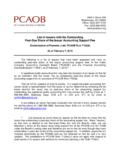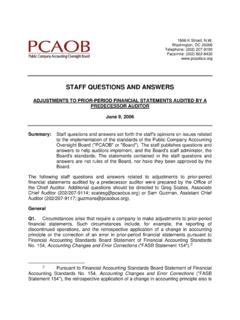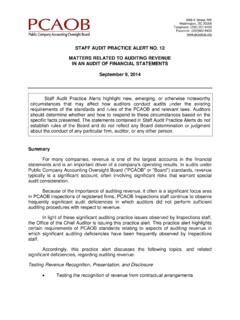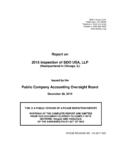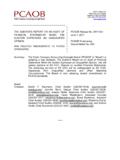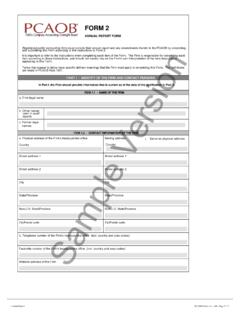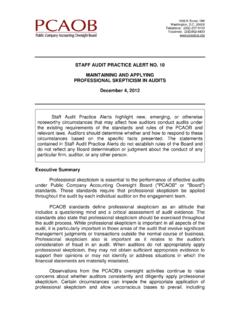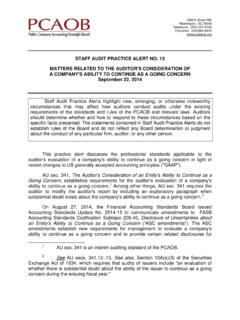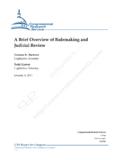Transcription of PCAOB Release No. 2015-002 Reorganization of PCAOB ...
1 1666 K Street, Washington, DC 20006 Telephone: (202) 207-9100 Facsimile: (202) 862-8430 Summary: After public comment, the Public Company Accounting Oversight Board (" PCAOB " or "Board") is adopting amendments that reorganize its auditing standards using a topical structure and a single, integrated numbering system. The Reorganization applies a standardized organizational structure to the Board's auditing standards that should help users navigate the standards more easily. Board Contacts: Martin F. Baumann, Chief Auditor (202/207-9192, Keith Wilson, Deputy Chief Auditor (202/207-9134, Greg Fletcher, Associate Chief Auditor (202/207-9203, and Robert Ravas, Assistant Chief Auditor (202/591-4306, * * * * * I.))))
2 Introduction The Board is reorganizing its auditing standards using a topical structure and a single, integrated numbering system. To implement this Reorganization , the Board is adopting amendments to its auditing standards and rules and is also rescinding certain auditing standards that are no longer necessary under the Reorganization . These amendments do not impose new requirements on auditors or change the substance of the requirements for performing and reporting on audits under PCAOB standards. Specifically, the amendments to implement the Reorganization include updates to the section numbers, cross references, and titles of certain standards.
3 Other related amendments include, among others, removing standards that are no longer necessary, replacing references to generally accepted auditing standards, and updating certain PCAOB rules to reflect the reorganized auditing standards. The new organizational structure is intended to improve the usability of the Board's standards, including helping users navigate the standards more easily. To Reorganization OF PCAOB AUDITING STANDARDS AND RELATED AMENDMENTS TO PCAOB STANDARDS AND RULES )))))))) PCAOB Release No. 2015 -002 March 31, 2015 PCAOB Rulemaking Docket Matter No.
4 40 PCAOB Release No. 2015 -002 March 31, 2015 Page 2 facilitate navigation, the standards are organized into a logical structure by topic areas that generally follow the flow of the audit process . For example, auditing standards that apply to procedures performed near the completion of the audit are arranged in the same area. The Reorganization also uses a numbering convention that is different from conventions used by other standard setters, which should help to avoid the potential for confusion between the standards of the Board and those of other standard setters. II. Background and The Need for Improvement PCAOB auditing standards currently consist of two types of equally authoritative auditing standards: (i) standards originally issued by the Auditing Standards Board ("ASB") of the American Institute of Certified Public Accountants ("AICPA") and adopted by the Board on an interim, transitional basis in April 2003 and (ii) standards issued by the Board.
5 In April 2003, the Board adopted, on an interim, transitional basis, generally accepted auditing standards that were in existence on April 16, When the Board adopted those auditing standards, it continued to use the topical organization and reference numbers ("AU sections") in the ASB's then-existing codification of its Auditing standards issued by the Board ("AS standards") have not been codified or otherwise organized by topic, and are numbered in sequential order based upon when they were issued. Thus far, the Board has issued 18 auditing standards (AS Nos.)
6 1 18), which have superseded 12 interim auditing standards and amended the majority of the remaining interim auditing standards to varying degrees. As a result, the Board's auditing standards are organized using two separate numbering systems: (i) the numbering system used by the ASB when the Board adopted the interim standards and (ii) the numbering system used by the Board for the standards it has issued. The Board undertook a project to consider enhancing the usability of the PCAOB auditing standards by reorganizing the standards using a single, integrated numbering system and a topical structure that generally follows the flow of the audit process .
7 In March 2013, the Board proposed an approach for reorganizing its auditing standards into a new organizational structure together with related amendments to its 1 See Establishment of Interim Professional Auditing Standards, PCAOB Release No. 2003-006 (Apr. 18, 2003) (adopting Rule 3200T, Interim Auditing Standards). 2 Since 2003, the ASB has modified the organizational structure of its standards as part of its Clarity Project. PCAOB Release No. 2015 -002 March 31, 2015 Page 3 auditing standards and rules ("original proposal").
8 3 That proposal set forth a framework for reordering and renumbering the existing auditing standards in their entirety, without redrafting the standards, imposing new requirements on auditors, or making substantive changes to the requirements. The original proposal also included amendments to rescind certain interim auditing standards that the Board believes are no longer necessary. In May 2014, the Board issued a supplemental request for comment ("supplemental request") on the original The supplemental request included proposed line-by-line amendments to PCAOB auditing standards and rules necessary to implement the proposed Reorganization along with certain changes to the Reorganization presented in the original The supplemental request also reopened the comment period on the original proposal to seek further comment on matters discussed in the original proposal, as well as on the implementing amendments in the supplemental request.
9 The Board received 19 comment letters on the original proposal and seven comment letters on the supplemental Commenters generally supported the proposed Reorganization of PCAOB auditing standards. Some commenters suggested modifications to the Board's proposal, including changes to the proposed Reorganization , which are described below. Sections III and IV of this Release describe the Reorganization and related amendments to PCAOB standards and rules and discuss comments received on the original proposal and supplemental request in greater detail.
10 3 See Proposed Framework for Reorganization of PCAOB Auditing Standards and Related Amendments to PCAOB Auditing Standards and Rules, PCAOB Release 2013-002 (March 26, 2013). 4 See Supplemental Request for Comment: Proposed Framework for Reorganization of PCAOB Auditing Standards and Related Amendments to PCAOB Auditing Standards and Rules, PCAOB Release 2014-001 (May 7, 2014). 5 At the same time, the Board released on its website an online demonstration version that presented the existing auditing standards as they would look if reorganized according to the proposed Reorganization .
